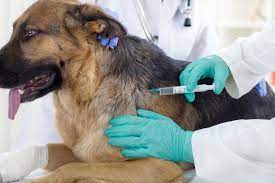Vaccination has been an effective way to reduce disease in animals and a very important tool in maintaining animal health and welfare.
Animals, like humans, are susceptible to a wide range of diseases caused by viruses, bacteria, fungi, and parasites.
Each of these diseases has vaccines that prevent or mitigate the losses or long term consequences of the disease.
Vaccination: What is contained in a vaccine?
When an animal is vaccinated, a small amount of a virus or bacteria is taken in by the animal either by injecting under the skin, in the muscle, or orally depending on the route of administration of the vaccine being given.
This organism that is taken in by the animal is normally a non-harmful strain of the virus or bacteria that we are protecting our animals against (for live vaccines) or a killed form of the actual disease-causing virus or bacteria ( for killed vaccines).
Therefore, in summary, a vaccine contains the following:
a. Live organisms (virus, bacteria) for live vaccines
b. Inactivated organisms, incapable of replicating in the body for killed vaccine
c. Specific proteins or sugars are known as antigens.

Vaccination: How do vaccines work?
Animals receive vaccines for the same reason that humans do: to prevent diseases.
Basically, the role of vaccination is to expose the naïve immune system (i.e the immune system of the bird that has not been exposed to the foreign organism) to the viral and bacterial antigens contained within the vaccine.
This is so that in future if and when an APPROPRIATELY vaccinated animal gets attacked by a related viral or bacterial antigens, the immune system will recognize the antigen in those disease-causing organism.
It will then be activated very quickly within hours to kill them and protect the animal from the disease.
When an animal that is not vaccinated is attacked by these diseases causing organisms, it will take weeks for the body of the animal to fight the organisms. This long period gives the organisms time to replicate and invade deep into the body.
Vaccination: Types of vaccines
There are two major vaccine types:
1. Live Vaccines also are known as an attenuated or avirulent vaccine.
They contain a whole live virus or bacteria. They are intact but weakened pathogens which are closely related to the wild type, disease-causing virus, or bacteria we are protecting our animals from. They stimulate an immune response but do not cause clinical disease.
When these vaccines are taken in by the animal through the necessary route of administration, they multiply within the cells and tissues of the animal.
They grow into large populations and this is a very good thing! This action exposes the immune system to a greater volume of viral vaccine antigens.
A greater immune response will be triggered to kill off these millions of viral antigens. This will result in higher levels of protective antibodies floating through the blood waiting to protect the body in face of attack with real disease-causing organisms.
2. Killed or inactivated Vaccine.
They contain completely inactivated pathogen which is no longer infectious. They are unable to replicate in the body of the animal and unable to cause disease in the animal.
They normally contain an adjuvant which is a compound added to help improve the protective immune response.
It is important to always remember that only healthy animals are vaccinated. A properly functioning immune system is needed to stimulate a good immune response and develop an effective level of protection.
To be continued: watch out for the vaccine types and the infections they protect against.
Read more HERE
Watch our videos HERE
